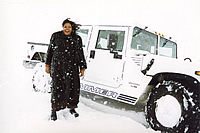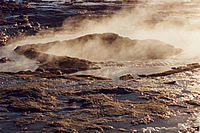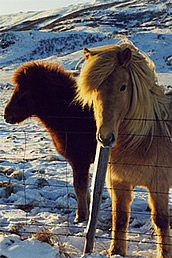I
grew up in a city, I live in a city and when I vacation, I usually head for a
city. I don't camp out in tents, unless they're the air-conditioned, carpeted and I don't believe in testing my physical limits through bungy-jumps
and dives off of high cliffs. I am fully convinced that I get all the exercise
I need dancing past sunrise at a club in Ibiza. Oh, and I don't like cold weather.
Imagine my uncertainty
when I found myself going to Iceland for two months in the middle of winter. Sure,
there are cities on Iceland, and there are more than enough nightclubs to keep
a visitor entertained for a couple of months, but Iceland is not about cities
and clubs. It is all about nature.
Most
visitors to Iceland will agree: the most lasting memory of Iceland is not the
mob scene at Nelly's on a Friday night, or even the superb fish at Einar Ben restaurant.
The most lasting impression of Iceland is the nature.
Never
have I seen a landscape like that. The barren land, ravaged by volcanic explosions
and massive glaciers, looks like a moon landscape. It comes as no surprise that
before they took off for the moon, NASA's Apollo 11 team practiced on the Icelandic
tundra. It looks like the moon, and when you get lost on one of those wide-open
plains, it feels just as remote.
Miles
and miles of…nothing
There
is a joke in Iceland: if you get lost in the woods in Iceland - stand up. Not
a particularly funny joke until you get out on the wide-open lava fields and realize
there is no vegetation higher than your kneecaps in sight. Then you start laughing,
but not a hearty laugh, more an insecure, I-am-a-very-little-person-in-a-very-big-world
kind of laugh.
There
used to be trees on Iceland. When the first settlers arrived from Norway in the
ninth century, the island was covered with birch trees. Trying to keep warm, the
settlers used the trees to heat their wooden houses. Excessive cropping, combined
with overgrazing, has caused the land to erode and is left barren.
| Every
country has its sore spot, a topic you're better off not bringing up at a cocktail
party. Don't talk to Germans about past treatment of religious minorities or to
the French about the invasion of American pop culture. In Iceland, it's the weather. |
Nowadays, heating
is no problem. The capital city of Reykjavik, and much of Iceland, is heated using
geothermal energy from the country's many hot springs. The hot water in Reykjavik
is natural hot water from a nearby spring. Clean and cheap, geothermal energy
lacks all the environmental downsides of traditional energy sources. Now if they
could only do something about that sulfurous smell.
Aside
from the Icelandic landscape, the second most unforgettable memory is of the Icelandic
men trying to show off this landscape. Icelanders are fiercely proud of their
land, and they will go to great lengths to make sure you fully grasp its extraordinary
beauty.
One blond
looker by the name of Gunnar told me that when he has visitors come in from overseas,
he takes them out in his car, leaves them on a lava field and tells them he'll
be back a couple of hours later. He says without fail, his visitors have tears
in their eyes when he picks them up. While I understand I am supposed to take
that as a sign of some kind of nature-induced epiphany, all I can think is that
if he dropped me off on a lava field and drove off, I'd cry too. His visitors
probably thought he was never coming back.
 |
| Travel
mate Marianne in front of a Hummer. With few roads and an uneven terrain, Iceland's
interior is often impassable. Hummers, originally designed for the US military,
are the only vehicles that can cross the Icelandic highlands. |
Stefan, owner of
the Hummer dealership in Iceland, thought the best way for us to see the landscape was through a ride in one of his Hummers. With few roads
and an uneven terrain, Iceland's interior is often impassable. Outfitted with
forty-four inch tires, the American military vehicle is the only vehicle that
can cross the Icelandic highlands.
Somewhere
along the highway between Reykjavik and Keflavik, Stefan took a sharp left turn,
straight out onto a snow-covered field and up the side of a mountain. Confirming
the feeling we already had in our stomachs, the instruments on the dashboard indicated
a steady eighty-degree angle.
Well
up on top of the mountain, we pried our fingers off the leather seats and stumbled
out to have a look around. Snow and haze prevented us from seeing anything further
away than few feet. It didn't matter.
Sometimes you're better off not seeing the vehicle you have to get back into dangerously
close to the edge of a mountaintop. We looked down on our high-heeled boots and
weighed the option of sliding down the mountainside versus getting back into the
Hummer. No point ruining a good pair of boots. We got back into the vehicle and
said our prayers.
Erupting
hot springs and plunging waterfalls
To see a bit more of the
landscape, from a more normal angle, we rented a SUV and headed east on the highway
out of Reykjavik. It was one of those rare sunny winter days you learn to treasure
at northern latitudes.
Our
goal: Geysir, the erupting hot spring that gave the English language the word
geyser. The original geyser is a little tired these days, but another geyser nearby,
Strokkur, sprouts more regularly. It erupts daily every fifteen minutes
between 9 and 5, the sign told us. Either the sign is a little misleading, or
God created the perfect tourist attraction. Strokkur didn't disappoint. On schedule
it spewed a jet of steaming water one hundred feet into the sky. With faces wet
from steam, we returned to the car to continue to our next stop, Gullfoss, Europe's
largest waterfall.
 |
| Active
hot spring Stokkur is about to erupt. Nearby hot spring Geysir gave the English
language the word geyser. |
According
to the map, it wasn't supposed to be very far. We should have been there,
but still no sign of a waterfall. We drove a little further, no waterfall.
We got out of
the car and looked around. Not only was there no sign of a waterfall, there was
no sign of a road.
We
had lost the road.
We were in the middle of a field, and for as far as we could see, there was nothing,
not a tree, not a bush, not a shrub. For a few minutes we stood there silent,
before the cold and the wind forced us back into the truck.
We
followed our track marks back and found where we had reared off the road. Careful
not to loose the road again, we followed the signs to the waterfall. Then we almost
missed it again. Not visible from the road, Gullfoss plunges 105 feet down into
a deep canyon. On sunny days, rainbows frame the waterfall. We counted half a
dozen rainbows in the mist from the double cascades that day.
Horseback
riding in the hail
Early on in our stay, my travel mate and I realized that if we were going
to wait for a sunny day, we wouldn't get any sightseeing done. So we went hiking,
horseback riding and snowmobiling in rain, hail, snow, sleet and sun. Oftentimes
all of the above - in the same day. There is another joke in Iceland: if you don't
like the weather - wait five minutes. Not a very funny joke either. Not until
you figure out that laughing warms you up a little. Then you laugh.
Every
country has its sore spot, a topic you're better off not bringing up at a cocktail
party. Don't talk to Germans about past treatment of religious minorities or to
the French about the invasion of American pop culture. In Iceland, it's the weather.
Iceland, Icelanders would tell us over and over, is really a misnomer. Greenland
is a lot colder and not at all that green. When you compare the two, Iceland is
not that cold, and a lot greener. Yes, but are you listening to yourselves? You're
comparing yourselves to Greenland. That's like saying compared to a rock,
a hard place is not a bad place to be. Iceland is cold. Magnificently beautiful,
but still cold. End of story.
When
in Iceland, you have to go horseback riding. The Icelandic horse, a small and
sturdy breed slightly taller than a pony, descends from a herd brought over by
the first Norse settlers eleven hundred years ago. No horses have been imported
to Iceland since. Over the centuries, the horse has adapted to the oftentimes-harsh
conditions of Iceland, growing smaller and stronger than its Nordic cousins. The
fifty-five-inch tall horses can reach a speed of thirty-five miles per hour and
carry well over two hundred pounds. The horses are kept outside year round, growing
a fuzzy coat in the winter months.
 |
| The
Icelandic horse, a small and sturdy breed slightly taller than a pony, descends
from a herd brought over by the first Norse settlers eleven hundred years ago.
To protect the island’s fragile ecosystem, no horses have been imported to
Iceland since. Once a horse leaves the country, it is not allowed back in. |
To make a closer
acquaintance with a couple of these animals we headed to a stable early one Saturday
morning. Fifty-five inches seemed a lot more impressive up close, and the fuzzy
coat, wet from rain and hail, didn't look as cuddly as it did in the brochures.
It was too late to turn around now. We borrowed some snowsuits and headed
out on the Icelandic tundra.
Icelandic
horses have five gaits. One gait, toelt, is unique to the breed and so smooth
the rider could carry a glass of water without spilling a drop.
My
horse decided on a different gait that day. The ride out on the fields was far
from smooth. I clutched my arms around his neck as I watched a couple of people
in my party dive nose first into the frozen mud.
After
an hour, trying dearly to hang on, we turned around a hill and onto a bigger path.
My horse knew this path. This was the path back to the stable. His little legs
started moving faster and he switched from his not-so-smooth to his even-rougher
gait. An hour in the hail was enough for both of us. Even hardy Icelandic horses
need their rest and shelter. Not to mention their riders.
Hot
dips and turquoise sips
Lack of trees and other tall objects
means a mean, straight-through-your-bones wind gushing in from the sea at all
time. The only time I felt completely warm in two months was at a dip in the Blue
Lagoon, a natural hot spring close to the Keflavik airport and a must for all
tourists.
The
spring's tourist trap reputation is really unfortunate, for it is truly a unique
experience. It is a strange feeling to walk from the dressing room, barefoot through
the snow, wearing nothing but a bikini in Iceland in January, and slip into a
104-degree hot spring. Once your feet get over the shock of the surroundings skipping
70 degrees in a matter of seconds, it's not at all an unpleasant experience. And
when a hunky bartender, wearing nothing but swim trunks and a bow tie, serves you
a turquoise drink perfectly matching the color of the hot spring, the experience
gets downright pleasant.
Made
up of two-thirds salt water and one-third fresh water, the water in the Blue Lagoon
is high in silica and algae, substances known for their natural healing powers.
The healing powers of the spring were discovered by accident in 1986 when a construction
worker working nearby noticed his psoriasis getting better after dips in the water.
The Icelandic Organization of Psoriasis Patients set up huts by the hot spring,
and in 1993 the commercial facilities of the Blue Lagoon opened up. Today the
Blue Lagoon treats five thousand Icelandic and a thousand international psoriasis
patients a year at a separate facility. While the water does not make the symptoms
go away permanently, it helps soothe the irritation.
Party
like a Viking
No
matter how cold, slushy and snowy it is outside, the Icelanders still go about
their business as usual. They work, study, play, shop. And on the weekends they
party. Every weekend. Year round. Hard.
| Sure,
you've been around drinking, and you've been known to down a few yourself, but
I'm pretty sure you're not used to seeing women your mother's age throwing up
in the gutters after last call, or having 14-year-olds buying you shots in bars. |
It might be snowing
sideways in Reykjavik in February, but you'll still see them heading for the bars
on a Friday or Saturday night. And rather than have to battle the mob at the coat
check, they brave the weather without coats, women in strappy dresses and high
heel sandals. While I would turn into an unattractive heap of blue goose bumps
if I did the same thing, these women look stunning. Tall, strong, take-no-crap-from-anybody
stunning. And they are strong. And they take no crap.
When one drunk-past-conscious guy, swinging a broken bottle uncontrollably, bothered
us on the dance floor, a woman came to our rescue, grabbing the guy by the hair
and pushing his face down on the dance floor. She then said something in Icelandic,
stomped her foot next to his face and walked away. The guy bothered us no more.
It is impossible
to write about the nightlife in Iceland, and not mention the drinking. Sure, you've
been around drinking, and you've been known to down a few yourself, but I'm pretty
sure you're not used to seeing women your mother's age throwing up in the gutters
after last call, or having 14-year-olds buying you shots in bars. (No hun, shots
are on me, my allowance is bigger than yours.)
There is an abundance of bars in downtown Reykjavik, around the streets Asturstraeti,
and up Bankastraeti (which somewhere along the way turns into Laugavegur). Rex
and Kaffi Brenslan are good places to start, and Astro and Nelly's good places
to end up. Avoid Broadway at all costs. If you are unsure of where to go, just
stand at a street corner and look lost, and a group of loud and happy Icelanders
will with no doubt drag you with them, because just as they want you to truly
experience the beauty of Iceland, they all want you to have a good time.
As
the night and the alcohol consumption advances, pickup lines get a lot less verbal.
At the end of the night, 'you, me', followed by a friendly grouping, seems to
suffice. One man suggested 'you, me, your friend, my place'. Baffled at our rejection,
he turned quite eloquent: 'If I stand up and you see me full figure, you'll change
your mind.'
I
didn't change my mind about him, but I did change my mind about Iceland. Iceland
is one cool place. Literally and figuratively.
If
You're Going:
Icelandair
(www.icelandair.net) has
daily flights from Baltimore, New York, Boston and Minneapolis to Iceland, and
nine daily flights from Iceland to Europe.
www.avis.is has information about car rentals,
and the Icelandic Tourist Board (www.icelandtouristboard.com)
offer information about lodging and dining.
For information
about snowmobile tours, and exciting adventures such as torch-lit tours through
glacier caves, visit www.samvinn.is/iceland
More
information about the Blue Lagoon, and Hummer safaris can be found at www.bluelagoon.is
and www.hummer.is. |